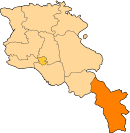- Nerqin Khndzoresk
-
Nerqin Khndzoresk
Ներքին Խնձորեսկ— community — Coordinates: 39°30′22″N 46°29′46″E / 39.50611°N 46.49611°ECoordinates: 39°30′22″N 46°29′46″E / 39.50611°N 46.49611°E Country Armenia Marz (Province) Syunik Area[1] – Total 6.18 km2 (2.4 sq mi) Population (2010) – Total 321 – Density 51.9/km2 (134.5/sq mi) Time zone (UTC+4) – Summer (DST) (UTC+5) Nerqin Khndzoresk at GEOnet Names Server Nerqin Khndzoresk (Armenian: Ներքին Խնձորեսկ, also Romanized as Nerkin Khndzoresk) is a village and rural community (municipality) in the Syunik Province of Armenia. The National Statistical Service of the Republic of Armenia (ARMSTAT) reported its population was 321 in 2010,[2] up from 184 at the 2001 census.[3]
Contents
Overview
Nerqin Khndzoresk, a border village in South-East Armenia, lies in Armenia’s Syunik Marz region. The small village is located 21 km from Goris off the Stepanakert highway. The village lies 7 km from the upper Khndzoresk village connected by farm fields and one bumpy dirt road. The remote village is positioned below the larger village and surrounded by rolling hills, gorges, and scenic mountains.
Population and infrastructure
The village of Nerqin Khndzoresk has approximately 320 people. The majority of the population is of Armenian descent, while the minority is Azerbaijian refugees who settled in the area after fleeing Azerbaijan during the war. The citizens are Armenian Apostolic Christians speaking Armenian and often Russian. The area is impoverished with little employment outside of self-sufficient farming and gardening. Substance farming and animal breeding are the main sources of livelihood. Throughout the village the social relationships are harmonious and the area is not segregated by class or occupation.
History
The village was founded in 1983 as a result of resizing of the bigger village of Khndzoresk. After the creation of Khndzoresk, Nerqin was established to strengthen the southeastern borders of Armenia and was strategically placed below the larger village to prevent enemies from attacking. However, any expansion and maintenance of the area ceased after the fall of the Soviet Union.
Cultural heritage
Government and politics
Education
The village has one school and one kindergarten. Nerqin Khndzoresk Secondary School has approximately 50 students, small but quite beautiful. The school is surrounded by swaying, tall grass fields, sunflowers, and fruit bearing trees. The school was founded on March 10th, 1989. The classes began in small cottages and continued to be held in modest areas until the renovation of the school in 2004. The school contains all grades (forms) 1-12. The class sizes range from 1 student to 9 students. The following subjects are taught: Armenian, Armenian Literature, Russian, Russian Literature, English, History, Armenian History, Armenian Church History, Math, Algebra, Geometry, Strategy, Biology, Physical Education, Art, Music, Healthy Lifestyles, Law, and Geography. School begins September 1st and goes through May 25th. The school’s vacation schedule is consistent with that of the rest of Armenia:
- Autumn Break: Usually last week of October
- Winter Break: Usually end of December to mid-January
- Spring Break: Usually last week of March
- Summer Break: Usually end of May to end of August
The daily school schedule begins at 9am and ends at 3pm with 5 minute breaks between each class and one 15 minute break after the third lesson. There are generally up to 6 classes within a day. Classes are attended Monday through Saturday and Sunday off.
Climate
The village has four distinct seasons. The summertime is generally quite hot, dry, and relatively humid. The fall often brings thick fog and rain. The winters are mild. The spring is relatively warm with lots of rain.The weather allows for a plethora of fruits and vegetables to be grown throughout the community. Most citizens have large gardens containing the following, but not limited to: potatoes, cucumber, tomato, squash, green beans, garlic, onion, peppers, cabbage, greens, sunflowers, apples, grapes, pineapples, cherries, plums, figs, apricots, pears, peach, watermelon, melon.
References
- ^ (Armenian) "Syunik regional e-Governance System". Syunik provincial government. http://Syunik.region.am. Click on link entitled "Համայնքներ" (community) and search for the place by Armenian name.
- ^ "Marzes of the Republic of Armenia and Yerevan City in Figures, 2010". National Statistical Service of the Republic of Armenia (ARMSTAT). http://www.armstat.am/file/article/marz_10_44.pdf.
- ^ Report of the results of the 2001 Armenian Census, National Statistical Service of the Republic of Armenia
Capital: KapanGoris 
Kapan Agarak · Aghvani · Antarashat · Arajadzor · Artsvanik · Atchanan · Chakaten · Chapni · David Bek · Dzorastan · Egheg · Eghvard · Geghanush · Geghi · Kaghnut · Kapan · Khdrants · Lernadzor · Nerqin Hand · Nerqin Khotanan · Nor Astghaberd · Norashenik · Okhtar · Qajaran · Qajaran · Sevaqar · Shikahogh · Shrvenants · Srashen · Syunik · Tandzaver · Tavrus · Tsav · Uzhanis · Vanek · Vardavanq · Verin KhotananSisian Aghitu · Akhlatyan · Angeghakot · Arevis · Ashotavan · Balak · Bnunis · Brnakot · Darbas · Dastakert · Getatagh · Gorayk · Hatsavan · Ishkhanasar · Lor · Ltsen · Mutsk · Njdeh · Noravan · Salvard · Sarnakunk · Shaghat · Shaki · Shenatagh · Sisian · Spandaryan · Tanahat · Tasik · Tolors · Torunik · Tsghuk · Uyts · Vaghatin · VorotanMeghri Categories:- Populated places in Syunik
- Communities in Syunik
Wikimedia Foundation. 2010.

